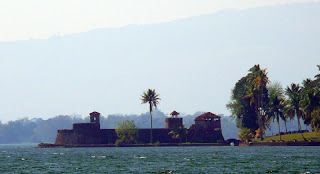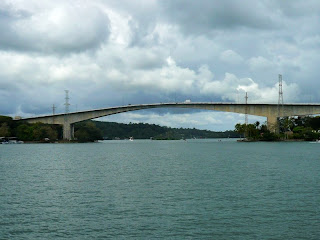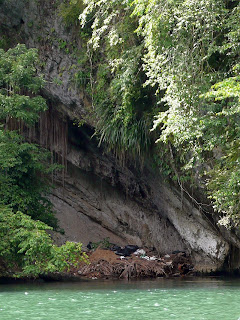This country is one of the least densely populated in the Americas, with only about 310,000 people on land about the size of Massachusetts. It’s practically empty! But such a variety of people and such a complex mix of races, languages and backgrounds!
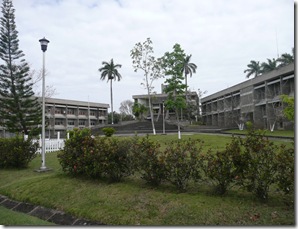
The capital, Belmopan, is barely a town of 12,000-15,000. Here’s the center of government as built by the British about 40 years ago, well inland, after yet another hurricane wreaked havoc on Belize City. But although the official seat of government moved, a lot of people prefer the funkier character of the coast. The British engineers were more interested in sturdy construction and good drains.
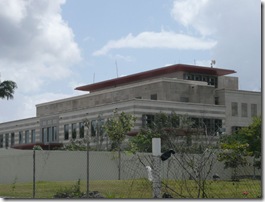
And here’s the American Embassy, only a couple years old, built for $80 million dollars, including two stories underground. There’s more around back. Even sturdier construction and better drains, I’d say. Also a sign forbidding photographs.
Wanting to go inland, we took the water taxi and public buses (BlueBird school buses) to Belmopan via the lovely Hummingbird Highway, one of four major paved roads in the country, then asked a taxi driver to show us the sights. These were: half a dozen embassies, the Chinese supermarkets, and the home of the richest man, whose fortune was based on telephone poles. We had lunch at the market across from the bus station and came back home.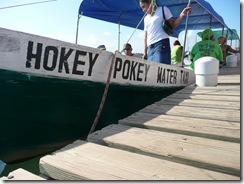
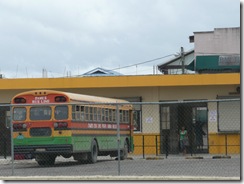
The biggest groups are Creole (“English”), descendants of slaves imported to work in the mahogany forests, , Mestizo (“Spanish” mixed Hispanic and Amerindian) , and Mayan, these days often refugees from Guatemala. Unlike many former colonies, this one, ex-British Honduras, never had a large European population during colonial times.
Finally found our Belize courtesy flag, whose coat of arms bears symbols of the mahogany industry which was the economy in the 18th and 19th centuries. It’s reminiscent of Maryland’s seal only instead of ‘strong deeds, soft words’ the Belize inscription means: In the shade, we thrive. The men are holding axes and saws, not fish and shovels. The picture is supposed to get bigger if you click on it.
We used to sew and paint our own courtesy flags, but this one, like Maryland, should be bought.
The Garifuna were originally from St. Vincent, descendants of African slaves with some intermarriage with Caribs, Arawaks and Europeans. As the Eastern Caribbean was exchanged between the British and French, they were in the way, and were shipped to Belize during the early 1800s. To this day, they have maintained their own cultural identity and account for about 7% of the population, and all the Rastas.
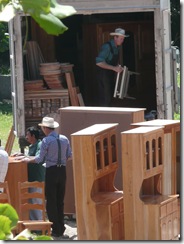
A small but distinct group are the Mennonites, who came en masse from Mexico in the late 1950s. “Mennonite farmers and businessmen are responsible for a major part of Belize food production. They produce a good portion of the country’s beef supply and most of the chicken, eggs, pasteurized milk and other dairy products. Mennonite farms also produce soybean for animal feed, red kidney beans, rice fruits and vegetables.” As they do elsewhere, they build furniture. They have been granted a certain autonomy in their communities, cannot vote and do not serve in the military. The same straw hats (not local!), the same black bonnets and overalls that they wear in Ohio, it appears.
You can read more here :http://www.reporter.bz/index.php?option=content&task=view&id=2607&Itemid=2.
Then there are East Indians, Arabs, and Chinese, who have come in greater numbers lately from Hong Kong and Taiwan and settled into a mercantile niche, particularly groceries and restaurants .
I feel like I’m writing a school report, but probably, on the subject of Belize, many people draw a blank. I continue because I was surprised at how different the feel of this ex-British Caribbean colony is from those of the Eastern Caribbean. There don’t seem to be such extremes of wealth, or the antipathies between groups that you sometimes see. Although the rhetoric for recent local elections was hot enough!
A good thing about this small population is the reduced pressure to deforest – Belize is trying hard to be an eco-tourist destination, and has apparently retained an impressive number of the larger jungle animals like jaguar and tapir, and birds. This NY Times article is old but I thought interesting on the subject of sustainable forestry. 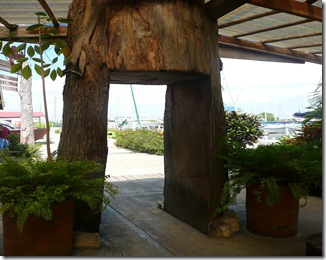 The gist of it is: Rainforest Action says “Boycott Mahogany” but others say that if the forests aren’t valuable, there will be no reason to keep them. Belize is still covered with tropical forests and half of it is in preservation, so here’s an opportunity to provide economic incentive not to turn diverse forests into citrus groves.
The gist of it is: Rainforest Action says “Boycott Mahogany” but others say that if the forests aren’t valuable, there will be no reason to keep them. Belize is still covered with tropical forests and half of it is in preservation, so here’s an opportunity to provide economic incentive not to turn diverse forests into citrus groves.
http://query.nytimes.com/gst/fullpage.html?res=9F03EEDC1F39F937A35755C0A960958260&n=Top/News/World/Countries%20and%20Territories/Belize




